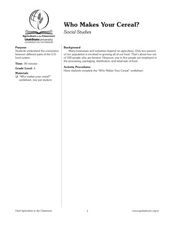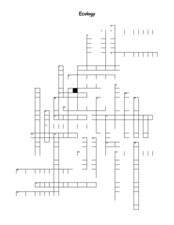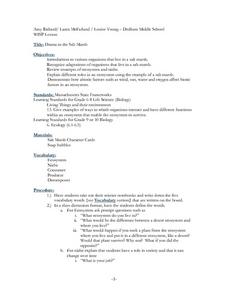Curated OER
A Day Without Agriculture
Second graders define and create a list of agricultural products. In this producers and consumers lesson, 2nd graders participate in a contest to find as many types of agriculture as they can. The student who comes up with the best...
Curated OER
Agriculture Pays
Second graders role play one of the jobs related to agriculture and explain their role in getting one of the five "f's" of agriculture to the consumer. In this agriculture lesson, 2nd graders are assigned a role and a commodity. Each...
Curated OER
Forest Food Chains and Webs
Students explore forest ecological systems. In this ecology lesson plan, students classify forest plants and animals according to their ecological roles. Students play a related vocabulary guessing game. Students choose a card on which...
Curated OER
Prairie Food Chains & Webs
Students complete a food chain. In this ecosystem lesson, students learn about producers, consumers and decomposers. Students identify herbivores, carnivores and omnivores and complete two worksheets.
Curated OER
Ecosystem Game
Students examine the ecosystem by playing a game. In this ecosystem lesson, students are put into groups of decomposers, consumers, and producers. Students create a list of animals that fit into each group and items that represent...
Curated OER
A Wild Chain Reaction
Students explore habitats. In this habitat lesson, students break into groups and are labeled as a part of a habitat. Students then do an activity with yarn that shows how all of the parts are connected and depend on each other....
Curated OER
Ecology Study Guide
In this ecology study guide, students fill in a table about producers, consumers and decomposers, they draw the water cycle, they fill in diagrams about cell respiration, the food pyramid, protein synthesis and nitrification, population...
Curated OER
Price
First graders complete worksheets on producers and consumers and the total price of a group of items. In this price lesson plan, 1st graders read the book A Dollar for Penny in order to understand price, producers, and consumers, and...
Curated OER
Who Makes Your Cereal?
Fourth graders investigate how cereal is produced. In this agricultural lesson, 4th graders discuss where ingredients in cereal come from. Students use picture cards to identify the steps in producing cereal.
Curated OER
Ecosystem Tumble
Learners create visual representations of ecosystems. In this ecology lesson plan, students discuss the interdependence of plants and animals in various ecosystems. Learners cut pictures from magazines and glue them on sturdy blocks. ...
Curated OER
Biodiversity in an Estuary
Young scholars investigate the biodiversity in estuaries. In this estuary lesson plan, students use Google Earth to explore the Rookery Bay National Estuarine Research Reserve. They produce a biodiversity concept map and portray the life...
Curated OER
Transfer of Energy
In this transfer of energy worksheet, young scholars complete a graphic organizer that shows the relationship between the sun, producers, first order consumers and second order consumers. They describe why it is important to understand...
Curated OER
Mini-Ponds
In this mini pond worksheet, learners create a mini-pond ecosystem with soil, water, and plant life. Students let their ecosystem sit for a day and they observe a sample the next day. Learners identify all the pond water microorganisms...
Curated OER
Ecosystems at School
In this ecosystem worksheet, students use a string and make a large circle. Everything in the circle is part of the ecosystem the students will study. They identify everything in their ecosystem and classify their data. They answer 2...
Curated OER
Texas Ecoregions Summary Sheet
In this ecoregions of Texas worksheet, students complete a summary of a particular ecoregion in Texas. They find the producers and consumers of the region, they draw a food chain, the draw a food web, and they complete an energy pyramid...
Curated OER
Flow of Energy Through An Ecosystem
In this flow of energy in an ecosystem, students complete a graphic organizer and show the flow of energy from the sun to producers, primary consumers, secondary consumers, tertiary consumers and then decomposers. Students define each of...
Curated OER
Food Web
In this food web worksheet, students label the organisms shown as a producer or consumer and as a carnivore, herbivore or omnivore. Students create their own food web with a list of given animals.
Curated OER
Interdependence and Adaptation
Fifth graders construct a food web to illustrate how animals and plants are interdependent. In this interdependence lesson, 5th graders identify how consumers, producers, herbivores, carnivores and predators are related in a habitat....
Curated OER
Energy Through the Ecosystem
In this ecosystem activity, learners use a diagram of an ocean-based food web to complete 5 short answer questions about the energy flow through this ecosystem.
Curated OER
Ecology
In this ecology activity, 6th graders will review ecology vocabulary words by circling the word that doesn't belong in each group of words for 6 questions. Then students will determine if 9 statements relating to animal and plant roles...
Curated OER
Giving'Em The Business
Young scholars work in groups of 4-5 to form a business, create, market & sell their product, and track their expenses and profits. They experience the roles of producer, distributor, and consumer of goods. They collect, organize...
Curated OER
Drama in the Salt Marsh
Students are introduced to the various organisms that live in a salt marsh. They recognize adaptations of organisms that live in the salt marsh. Pupils review concepts of the ecosystem and niche. Students explain the different roles...
Curated OER
First Grade Economics Unit
First graders begin by studying the differences between a "good" and a "service". They compare items to each other to help comprehend the differences. They also look into the differences between buyers and sellers and how the choices...
Curated OER
Ecosystem Interactions in Refuges
Seventh graders, using national parks as models, illustrate the energy flow in ecosystems. Working in groups, they use murals, flow charts, or other visual displays to record their findings. Students represent the food chains and webs...

























